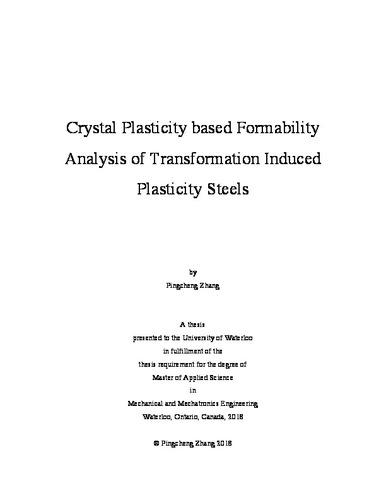| dc.contributor.author | Zhang, Pingcheng | |
| dc.date.accessioned | 2018-01-23 18:43:46 (GMT) | |
| dc.date.available | 2018-01-23 18:43:46 (GMT) | |
| dc.date.issued | 2018-01-23 | |
| dc.date.submitted | 2017-12-22 | |
| dc.identifier.uri | http://hdl.handle.net/10012/12941 | |
| dc.description.abstract | This thesis outlines a framework to model to aid the development and utilization of transformation induced plasticity (TRIP) assisted multiphase steels in the automotive industry for light weighting applications. Automakers rely on accurate characterization and prediction of sheet metal formability to implement these materials into the structure successfully. They rely on accurate numerical models for predicting and evaluating sheet formability compared to the costly experimental method. However, predictive modeling of TRIP steel in formability is difficult due to the combination of dislocation and transformation mechanisms occurring during deformation for various strain paths. This research is aimed to provide a tool to quickly and accurately capture the micro and macro mechanical response of TRIP assisted steels, as well as calculating the forming limit diagram used in evaluating formability.
This thesis presents a rate-dependent Taylor type elasto-viscoplastic crystal plasticity model with a micro-mechanics based transformation criteria to simulate the mechanical response of TRIP steel. A new stress-based transformation criterion, based on the micromechanics of habit- plane interaction, was developed to initiate transformation. This model inherently captures the triaxiality effect of martensite through the accumulated shear strain on slip systems. Simulations are calibrated and compared to experimental measurements of Duplex Stainless Steel (DSS). Simulations of single crystal and polycrystalline aggregates show that although high Schmid factor habit planes were favourable for transformation, competition exists between the lower Schmid factor dislocation planes that generate higher elastic stress needed for transformation. The calibrated model is then used to predict the forming limit diagram using the Marciniak-Kuczynski approach. The mechanism of transforming from low strength austenite to high strength martensite showed enhanced formability by at least 20% compared to without transformation. This is achieved by the TRIP mechanism suppressing localization at critical moments during deformation. However, the single variant martensite selection scheme had a negligible influence on formability predictions. Through a parametric study of the transformation criteria, formability can be enhanced on the biaxial regime by up to 13% over the baseline DSS material. Conversely, poor control of the transformation parameters could lead to a reduction of 50% in formability. The results highlight the importance of a physics based simulation to utilize TRIP assisted steels fully. | en |
| dc.language.iso | en | en |
| dc.publisher | University of Waterloo | en |
| dc.subject | Advanced High Strength Steel | en |
| dc.subject | Transformation Induced Plasticity | en |
| dc.subject | Forming Limit Diagram | en |
| dc.subject | Numerical Modelling | en |
| dc.subject | Crystal Plasticity | en |
| dc.title | Crystal Plasticity based Formability Analysis of Transformation Induced Plasticity Steels | en |
| dc.type | Master Thesis | en |
| dc.pending | false | |
| uws-etd.degree.department | Mechanical and Mechatronics Engineering | en |
| uws-etd.degree.discipline | Mechanical Engineering | en |
| uws-etd.degree.grantor | University of Waterloo | en |
| uws-etd.degree | Master of Applied Science | en |
| uws.contributor.advisor | Inal, Kaan | |
| uws.contributor.affiliation1 | Faculty of Engineering | en |
| uws.published.city | Waterloo | en |
| uws.published.country | Canada | en |
| uws.published.province | Ontario | en |
| uws.typeOfResource | Text | en |
| uws.peerReviewStatus | Unreviewed | en |
| uws.scholarLevel | Graduate | en |

